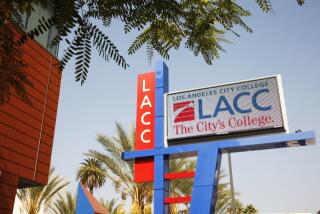Chapman College Ready for New Name, Mission
- Share via
ORANGE — Under the great wooden beams of Chapman College’s main auditorium, the crowd of new freshmen and transfer students squirmed excitedly as a diminutive dark-haired man stepped to the podium.
“I want to be the first to welcome you as the first entering class of Chapman University,” President James L. Doti told the eager newcomers.
Many leaped to their feet. Whistles and shouts of approval echoed through the Elizabethan-style theatrical hall.
“Everyone was excited,” recalled senior Kati Spencer, editor of the campus newspaper, the Panther. “Everywhere else, it’s really hard for freshmen and transfers to find a place, and here’s Chapman, welcoming them with open arms and telling them they are going to do wonderful things at this new university. . . . It sounds corny, but we really are going to be part of Chapman history.”
With a new and popular president at the helm, Chapman College on Tuesday will officially shed a 130-year identity and set a course for the future as Chapman University, a 2,300-student campus in Orange and a network of 51 academic centers across the United States and the Pacific Rim.
In the process, the Christian-affiliated liberal arts college is redefining itself and its position in the educational marketplace as both a traditional center of learning and a nexus of graduate professional programs in disciplines such as teaching, business, economics and communications, both at home and abroad.
After two years of turmoil under controversial former president Allen E. Koenig, who resigned abruptly in June after much-publicized brushes with the faculty over the mission of the college, there is an unprecedented mood of exhilaration about the future under Doti, a longtime Chapman professor and a highly respected economic forecaster in Orange County.
“I’m as optimistic as I’ve ever been about the institution,” said Karl Reitz, head of Chapman’s natural sciences division, who began his 26th fall at the college.
Barbara Tye, dean of Chapman’s newly reorganized School of Education, concurred.
“We’re feeling a sense of buoyancy and high morale regardless of what we call ourselves,” said Tye, a nine-year Chapman professor. “Jim (Doti) has a way of involving people, making them feel part of the organization--something that people didn’t feel for the last two years.”
Added George Argyros, chairman of the board of trustees: “Chapman is on the threshold of entering the 21st Century. I think we have strategically put the school in a position to take advantage of its educational capabilities and its geographic location.”
The name change, the college’s sixth since it opened as Hesperian College in Northern California in 1861, could be viewed as mere window dressing, a title bought for the price of a $20 state application fee. (No new accreditation for the four-year institution is needed because the accrediting agency, the Western Assn. of Schools, does not view the name change as a substantive change.)
One reason for the new name was a recent marketing survey that showed trustees the public confused the title “college” with two-year community colleges. Moreover, in some European and Asian counties, the term is synonymous with the equivalent of high school.
To Doti, the trustees and faculty, however, the name “university” is a recognition of changes that already have occurred to shape the once deficit-ridden college and a symbol of things to come.
“I really think we’ve been a university for quite awhile; we just haven’t called ourselves that,” said Doti, 44, a Chicago native who served twice before as acting president in the 1980s. “But this is the beginning of a new era. I think a lot of exciting new things are going to happen.”
It’s more than just a new leader, a new name and the promise of things to come that have faculty, students and trustees alike talking about Chapman’s potential, especially in an area where public universities are turning away students because of budget cuts.
The fall semester opened with a new dormitory, the first construction in more than a decade on the campus nestled in historic Old Towne Orange. Bulldozers now are busy preparing the grounds for a second new building, a 95,000-square-foot student center and conference facility to be named for Argyros, a wealthy Orange County developer and former owner of the Seattle Mariners who graduated from the college in 1959.
The campus has been recast as a central liberal arts college and four schools geared toward professional careers. Most of the pieces already existed, but they were reorganized in a more traditional university fashion, say campus officials.
More emphasis also is being given to programs that prepare undergraduates for careers.
“We’re offering degrees in film and theater, in advertising, journalism and even interior design,” Doti said.
Doti is cautious about discussing his vision for Chapman, in part because he is saving his message for Tuesday’s ceremonies. Another reason is that he plans to ask faculty, alumni and students to help draft a new mission statement that will carry them into the next century.
Reitz, who heads up the natural sciences department within the Wilkinson College of Arts and Sciences, predicts that Doti also will foster more entrepreneurial activities on campus.
“He’s willing to back us when new ideas come forth that look promising,” Reitz said. “In my domain, I’m looking forward to spinning off a school for health sciences and possibly a center for applied research that will do contracting work with industry.”
Doti sees enrollment eventually growing to the equivalent of about 2,500 full-time students on the Orange campus. Chapman’s current enrollment is the equivalent of about 1,900 full-time students, he said.
Growth is controversial in Orange, where neighbors have resisted expansion of the college, particularly construction of modern towers they feel do not belong in an enclave of historic dwellings on quiet, tree-lined streets.
“There will always be tension because the campus is growing,” said Doti, who has lived in Orange for most of the 17 years he has taught at Chapman. “But the school also offers open space, library facilities and cultural opportunities that they otherwise would not have. . . . We try to do our job and be the best neighbor possible.”
As acting president, Doti was credited as playing peacemaker with community opposition groups, a man who reassured them that he and most faculty have roots in Orange and prize its small-town atmosphere.
Those same qualities--one who considers another’s point of view and discusses options--made him the faculty’s preference for the permanent job when Chapman’s 10th president, G.T. (Buck) Smith resigned in May, 1988.
In August, 1989, trustees led by Argyros instead chose Koenig, a last-minute entry in an 18-month presidential search. Koenig resigned suddenly June 11, citing unspecified personal and family reasons. His departure followed four months of tension over the campus reorganization plan, an overwhelming no-confidence vote by students and a dispute over a previously unenforced rule requiring all students under 21 to live on campus.
“Even though Koenig was a communications major, he could not communicate,” said senior Travis Hull, a great-grandson of Charles Clarke Chapman, the college’s chief benefactor and the man for whom it was renamed in 1934 while still based in Los Angeles.
“It was a bad marriage,” said the 23-year-old Hull, who said he liked Koenig.
The embattled president and trustees ultimately agreed that his leadership had been irreparably damaged.
“Koenig is a wonderful man, and he helped bring us a lot of change,” said trustee Harmon Wilkinson, 78, of Whittier. “He’s aggressive and he had a lot of foresight. . . . It just wasn’t a good fit.”
Once trustees learned that faculty had considered censuring their president, they decided that “it was really time to cut bait,” Wilkinson said. “The chemistry between faculty and Koenig being what it was, there was a fear things weren’t going to smooth out.”
Two days before trustees met formally to accept Koenig’s resignation on June 11, Argyros asked Doti, while the two traveled to Washington, if he wanted the presidency Doti said yes.
But why didn’t they choose him in the first place?
“Maybe we were too close to Jim to really feel we had developed a person in our midst who could carry the load,” Wilkinson said. “You know what they say, a lot of times a prophet is without honor in his own country. . . . We wanted that school to go forward to become a first-class institution, so we were reaching outside.”
They turned to the economics professor this time because “Jim was still there and still performing in first-class fashion,” Wilkinson said. “There was just a feeling that he was the right person for the job. . . . He’s extremely loyal to the college.
“Gosh, a lot of guys would have called it quits and left if they had been passed over like that. Darned if Jim didn’t just maintain a marvelous attitude during the two years Koenig was with us.”
Now a visiting professor of communications at Boston University, Koenig could not be reached for comment. Trustees would not discuss details of his separation agreement.
Difficult decisions remain ahead for Chapman University, which like many private colleges and other labor-intensive businesses, has experienced more than a decade of sharply escalating costs. Chapman now has an operations budget of $50 million, which mainly comes from yearly tuition of $12,974 per student. Room and board costs another $5,000 to $6,700.
One project on Doti’s agenda is to build up Chapman’s $30-million endowment fund. If Doti commands deep faculty loyalty, his ties are equally strong to Orange County’s most influential and wealthiest business leaders after 11 years of forecasting economic trends in the county and the nation, say faculty and trustees.
“With the reputation he enjoys in the business community, he will be able to lead the campus forward,” said Chapman faculty chairman Myron Yeager. “He’ll be able to help the college meet the challenges ahead because he’s a business leader . . . but he’s also an academician.”
That dual nature is evident as Doti talks about resuming teaching with one class in the spring. He also plans to continue at Chapman’s Center for Economic Research, which after 13 years still has the nation’s only econometric model for a single metropolitan area.
“I’m going to still do the forecasting,” he said, his blue eyes creasing impishly as he gestures toward the immaculate cherry-wood desk in his spacious gray-trimmed office. “I need something to get me away from this grief.”
Chronology of Chapman College
March 4, 1861--Hesperian College holds its first session in the Northern California town of Woodland on the day and hour President Abraham Lincoln is inaugurated.
1896--Hesperian and its sister college, Pierce College, are incorporated with the Berkeley Bible Seminary in Berkeley. This is the first link in a chain of colleges to be affiliated with the Christian Church (Disciples of Christ) in California.
1920--The assets of Berkeley Bible Seminary (valued at $50,000) are turned over to the newly incorporated California School of Christianity in Los Angeles.
Sept. 13, 1920--California School of Christianity opens its doors in temporary quarters in the Wilshire Boulevard Christian Church in Los Angeles.
Sept. 12, 1921--College opens for classes on its own campus on North Vermont Avenue, opposite USC’s Southern Branch, which later moved to Westwood and became UCLA. California School of Christianity students take their liberal arts courses at UC and courses in religious education, drama, music, fine arts and public speaking at their home campus.
1923--The college changes its name to California Christian College, its original incorporation title.
1934--The Board of Trustees changes the name to Chapman College, after board chairman and principal benefactor Charles C. Chapman, a wealthy Placentia citrus grower and businessman.
1942--The U.S. Navy needs the Vermont Avenue campus for an engineering school, so Chapman College moves its students to Whittier College, where it shares facilities until the move back to Vermont Avenue in 1945.
1954--Needing room for expansion, Chapman College buys the old Orange High School campus at Glassell Street and Palm Avenue and becomes Orange County’s first four-year accredited college.
1965--Chapman College launches its World Campus Afloat program, which provided study tours for students from 200 colleges and universities. Program is disbanded in the mid 1970s, largely due to prohibitive costs.
1977--G.T. (Buck) Smith takes over as president of a college that has a deficit of $115,000, has too few students and is under-endowed at $700,000. He embarks on a program to build the endowment and enrollment. By 1986, the college was in the black, had 1,500 students and endowment pledges and grants of $25 million.
May, 1988--Smith resigns after 10 years as president, taking the newly created post of college chancellor. Business school dean James L. Doti, Orange County’s leading economic forecaster, is named acting president.
Aug. 23, 1989--Chapman College trustees name Allen E. Koenig the 11th president of the institution after an 18-month search. Koenig had been president of Boston’s Emerson College, where faculty opposed his plans to move the college.
February, 1991--Koenig unveils a reorganization plan that would cut faculty positions nearly 20%, increase class size, strengthen professional programs and de-emphasize liberal arts. Faculty members oppose the plan and a special task force is created to draft a new one.
April, 1991--A faculty task force’s consensus plan for reorganization is accepted by Koenig. The board of trustees approves the plan and unanimously votes to change the college name to Chapman University in the coming academic year.
June 11, 1991--The board of trustees accepts Koenig’s resignation for personal and family reasons.
June 12, 1991--The board of trustees names the college’s 12th president, Doti, who was the runner-up to Koenig in 1989.
On Sept. 10, 1991, Chapman College formally becomes Chapman University with a celebration and parade.
Sources: Autobiography of Charles C. Chapman, published 1976, and Chapman College.
More to Read
Sign up for Essential California
The most important California stories and recommendations in your inbox every morning.
You may occasionally receive promotional content from the Los Angeles Times.










